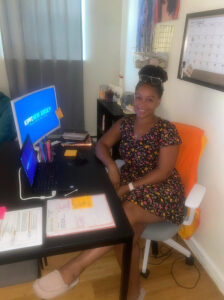
When 26-year-old Teesha Robinson logged on to Zoom for her first day of remote teaching, on August 24, she was hesitant. As she prepared to welcome her fifth grade students to their virtual classroom, a sudden crash on the east coast Zoom network halted all operations. This left Robinson unnerved, scrambling to reassure parents and students amid an already unusual way to start the school year.
“The first day was extremely nerve-wracking,” said Robinson, a math teacher at KIPP Bold Academy in Newark, NJ. “Starting in a territory that we had very little experience and training in, of course we’re going into the first day already very tentative. It’s a 2020 nightmare.”
For many educators nationwide, the first day of school looked very different this year. In the wake of the coronavirus pandemic, classrooms have shifted to fully virtual formats, a completely new means of teaching for Robinson and her students. These circumstances were unexpected and as the weeks go by, fellow teachers are reflecting on lost opportunities and loosening expectations for the school year.
“As a new teacher at my new school I was looking forward to using what I learned last year and doing things differently,” said Camille Handy, a 27-year-old first grade teacher at KIPP Life Academy in Newark, NJ. “I believe new teachers to this field may feel this way as they won’t get that classroom experience.”
Handy was preparing to implement more technology for in-person instruction this year, but the switch to virtual learning was not the technological immersion she hoped for.
“Weirdly enough I was actually looking forward to using more technology in person with my kids,” Handy said. “There are so many apps that can be used to teach math and literacy. I really wanted the opportunity to teach them about these technologies versus throwing them at the kids.”
Virtual learning is foreign to these teachers and that is tenfold for students, especially those at the lower elementary level. Aarion Moore, a 24-year-old kindergarten teacher and colleague of Handy, described the struggles she faces to engage young students online.
“I was really looking forward to welcoming my babies into kindergarten with open arms and giving them a hands on experience with school,” Moore said. “I feel like I have to do the absolute most to keep them engaged because sitting in front of a computer for hours is exhausting for anyone, especially 5-year-olds.”
A hands-on or kinesthetic experience is one component that makes in-person instruction crucial for 24 year-old Quincey Schenk and her fourth-graders at McKinley Community School in New Brunswick, NJ. In her self-contained, Multiple Disabilities (MD) class, Schenk appeals to three learning styles–visual, kinesthetic and auditory–to help her students succeed. She said that “the biggest piece they’ll be missing is kinesthetic” in addition to “social skills.”
Social life or “classroom culture” as Robinson calls it, is one of the harder elements to emulate with virtual learning. In her math class this year, she wanted to create a student-led environment, but boundaries posed by Zoom have put that mission on hold. Instead, Robinson teaches in somewhat of a survival mode.
“With so much learning lost I feel as if I’m taking the reins to prevent them from losing anymore,” Robinson said.
As this school year continues, these teachers are trying their best to make the most out of unprecedented circumstances. “I don’t think virtual will ever be better than in person instruction,” Schenk said. “But if my kids are happy, I’m happy.”








